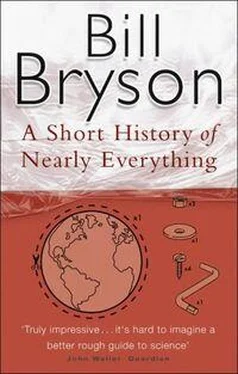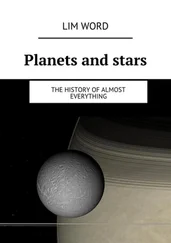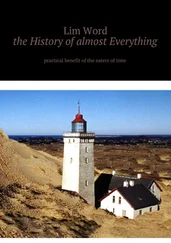Delicacy was the key word. Not a whisper of disturbance could be allowed into the room containing the apparatus, so Cavendish took up a position in an adjoining room and made his observations with a telescope aimed through a peephole. The work was incredibly exacting and involved seventeen delicate, interconnected measurements, which together took nearly a year to complete. When at last he had finished his calculations, Cavendish announced that the Earth weighed a little over 13,000,000,000,000,000,000,000 pounds, or six billion trillion metric tons, to use the modern measure. (A metric ton is 1,000 kilograms or 2,205 pounds.)
Today, scientists have at their disposal machines so precise they can detect the weight of a single bacterium and so sensitive that readings can be disturbed by someone yawning seventy-five feet away, but they have not significantly improved on Cavendish’s measurements of 1797. The current best estimate for Earth’s weight is 5.9725 billion trillion metric tons, a difference of only about 1 percent from Cavendish’s finding. Interestingly, all of this merely confirmed estimates made by Newton 110 years before Cavendish without any experimental evidence at all.
So, by the late eighteenth century scientists knew very precisely the shape and dimensions of the Earth and its distance from the Sun and planets; and now Cavendish, without even leaving home, had given them its weight. So you might think that determining the age of the Earth would be relatively straightforward. After all, the necessary materials were literally at their feet. But no. Human beings would split the atom and invent television, nylon, and instant coffee before they could figure out the age of their own planet.
To understand why, we must travel north to Scotland and begin with a brilliant and genial man, of whom few have ever heard, who had just invented a new science called geology.
AT JUST THE time that Henry Cavendish was completing his experiments in London, four hundred miles away in Edinburgh another kind of concluding moment was about to take place with the death of James Hutton. This was bad news for Hutton, of course, but good news for science as it cleared the way for a man named John Playfair to rewrite Hutton’s work without fear of embarrassment.
Hutton was by all accounts a man of the keenest insights and liveliest conversation, a delight in company, and without rival when it came to understanding the mysterious slow processes that shaped the Earth. Unfortunately, it was beyond him to set down his notions in a form that anyone could begin to understand. He was, as one biographer observed with an all but audible sigh, “almost entirely innocent of rhetorical accomplishments.” Nearly every line he penned was an invitation to slumber. Here he is in his 1795 masterwork, A Theory of the Earth with Proofs and Illustrations , discussing . . . something:
The world which we inhabit is composed of the materials, not of the earth which was the immediate predecessor of the present, but of the earth which, in ascending from the present, we consider as the third, and which had preceded the land that was above the surface of the sea, while our present land was yet beneath the water of the ocean.
Yet almost singlehandedly, and quite brilliantly, he created the science of geology and transformed our understanding of the Earth. Hutton was born in 1726 into a prosperous Scottish family, and enjoyed the sort of material comfort that allowed him to pass much of his life in a genially expansive round of light work and intellectual betterment. He studied medicine, but found it not to his liking and turned instead to farming, which he followed in a relaxed and scientific way on the family estate in Berwickshire. Tiring of field and flock, in 1768 he moved to Edinburgh, where he founded a successful business producing sal ammoniac from coal soot, and busied himself with various scientific pursuits. Edinburgh at that time was a center of intellectual vigor, and Hutton luxuriated in its enriching possibilities. He became a leading member of a society called the Oyster Club, where he passed his evenings in the company of men such as the economist Adam Smith, the chemist Joseph Black, and the philosopher David Hume, as well as such occasional visiting sparks as Benjamin Franklin and James Watt.
In the tradition of the day, Hutton took an interest in nearly everything, from mineralogy to metaphysics. He conducted experiments with chemicals, investigated methods of coal mining and canal building, toured salt mines, speculated on the mechanisms of heredity, collected fossils, and propounded theories on rain, the composition of air, and the laws of motion, among much else. But his particular interest was geology.
Among the questions that attracted interest in that fanatically inquisitive age was one that had puzzled people for a very long time-namely, why ancient clamshells and other marine fossils were so often found on mountaintops. How on earth did they get there? Those who thought they had a solution fell into two opposing camps. One group, known as the Neptunists, was convinced that everything on Earth, including seashells in improbably lofty places, could be explained by rising and falling sea levels. They believed that mountains, hills, and other features were as old as the Earth itself, and were changed only when water sloshed over them during periods of global flooding.
Opposing them were the Plutonists, who noted that volcanoes and earthquakes, among other enlivening agents, continually changed the face of the planet but clearly owed nothing to wayward seas. The Plutonists also raised awkward questions about where all the water went when it wasn’t in flood. If there was enough of it at times to cover the Alps, then where, pray, was it during times of tranquility, such as now? Their belief was that the Earth was subject to profound internal forces as well as surface ones. However, they couldn’t convincingly explain how all those clamshells got up there.
It was while puzzling over these matters that Hutton had a series of exceptional insights. From looking at his own farmland, he could see that soil was created by the erosion of rocks and that particles of this soil were continually washed away and carried off by streams and rivers and redeposited elsewhere. He realized that if such a process were carried to its natural conclusion then Earth would eventually be worn quite smooth. Yet everywhere around him there were hills. Clearly there had to be some additional process, some form of renewal and uplift, that created new hills and mountains to keep the cycle going. The marine fossils on mountaintops, he decided, had not been deposited during floods, but had risen along with the mountains themselves. He also deduced that it was heat within the Earth that created new rocks and continents and thrust up mountain chains. It is not too much to say that geologists wouldn’t grasp the full implications of this thought for two hundred years, when finally they adopted plate tectonics. Above all, what Hutton’s theories suggested was that Earth processes required huge amounts of time, far more than anyone had ever dreamed. There were enough insights here to transform utterly our understanding of the Earth.
In 1785, Hutton worked his ideas up into a long paper, which was read at consecutive meetings of the Royal Society of Edinburgh. It attracted almost no notice at all. It’s not hard to see why. Here, in part, is how he presented it to his audience:
In the one case, the forming cause is in the body which is separated; for, after the body has been actuated by heat, it is by the reaction of the proper matter of the body, that the chasm which constitutes the vein is formed. In the other case, again, the cause is extrinsic in relation to the body in which the chasm is formed. There has been the most violent fracture and divulsion; but the cause is still to seek; and it appears not in the vein; for it is not every fracture and dislocation of the solid body of our earth, in which minerals, or the proper substances of mineral veins, are found.
Читать дальше












